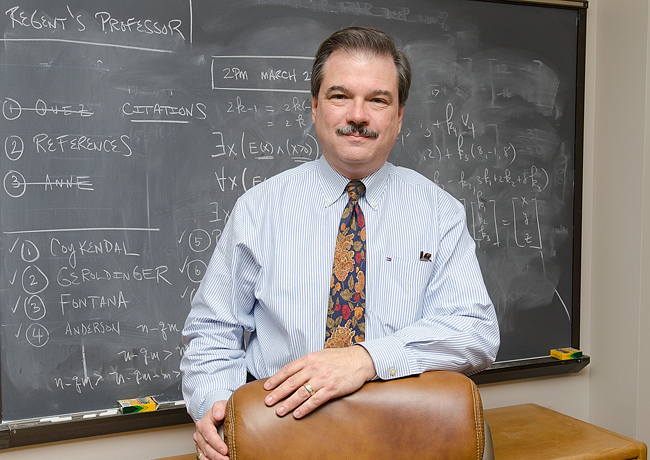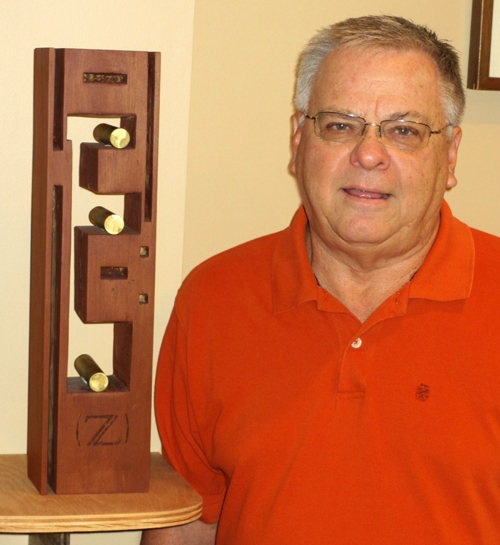Artist Brings Prof's Research To Life, Creating Unusual Piece From Unusual Theory
Aug. 2, 2013
SHSU Media Contact: Jennifer Gauntt
Story By: Meredith Mohr
 |
| Scott Chapman is a professor of mathematics and the editor of The American Mathematical Monthly journal, currently housed at SHSU. He collaborated with his friend and former colleague Gaylon Greger to create an "unusual piece of art dealing with an unusual piece of theory," as Greger calls the project. —Photo by Brian Blalock |
Sam Houston State University math professor Scott Chapman’s work is about breaking things down; for years, he has solved math problems by breaking large problem into smaller, more manageable pieces.
Conversely, as an artist, Gaylon Rex Greger’s work is about building things out of nothing; working primarily in sculpture and abstract expressionism, he makes visual and creative statements that reflect overarching ideas.
So it was quite the combination when, as former colleagues at Trinity University in San Antonio, Chapman’s and Greger’s work collided. The result was a piece of art that represents both of their worlds.
Greger, taking inspiration from a theoretical paper Chapman had written, created a sculpture “characterizing” the concept of block monoids.
A block monoid is an algebraic structure that was created to help understand certain numbers that do not follow the usual pattern of unique factorization.
Chapman explained that in general, most numbers factor uniquely. Prime numbers are known as such because they only factor as themselves times one. This is supported by a famous math theorem that states that an integer has a unique factorization in terms of prime numbers. For instance, six factors uniquely to two times three or three times two, and there are no other ways of reaching six except six times one.
“Everything in front of us has a structure, and more often than not, that structure can be explained with math,” Chapman said. “Any branch of mathematics attempts to better explain certain structures, whether they are physical or theoretical.”
The characterization of block monoid evolved from a joke with Chapman’s students several years ago, when he was running a summer program called Research Experiences for Undergraduates at Trinity University. Students from all over the country would travel to Trinity to do math research projects with him as part of the REU.
“One year, around the time Facebook was getting popular, I started a Facebook page, but to keep my identity private, I named myself ‘block monoid,’” Chapman said. “My students got a kick out of trying to figure out who it was, and it became a game while they were working with me on math research projects that summer. Gaylon, a friend and colleague, became fascinated with the idea after he heard that story.”
From there, Greger said he began the process of turning Texas red cedar wood and brass into sculpture form.
“I started thinking, ‘what would it look like if the block monoid was a real person?’” Greger said. “When I was forming the sculpture, I kept in mind certain elements from Chapman’s paper, and tried to translate those into what I envisioned as the block monoid’s physical appearance.”
Greger said that the sculpture plays with shapes and designs that represent different elements in math, such as geometry and prime numbers. One part of the sculpture features three holes, intended to remind viewers that three is a prime number.
 |
| Greger was inspired by Chapman's research on an algebraic structure called "block monoid." The finished product, above (with Greger), incorporates mathematical elements such as geometry and prime numbers. —Submitted photo |
Greger, who says he’s not a mathematician, has found the sculpture to be popular with both mathematicians, artists and everyone in between.
“I have had several offers from art collectors to buy it. I think mostly it appeals aesthetically to people. I always have to explain why it is called ‘block monoid’ and that doesn’t always go over well, “ Greger said. “I have had a few people who understand it. Having people understand it wasn’t the most important thing in this project; it was just to be playful and have fun with a math concept.”
Greger, who started his project with only Chapman’s formal paper, noted laughingly however, that as “ an unknowing math person,” “probably only mathematicians could tell you if it is a concept or a theory.”
Chapman said the idea of turning math into art is more intuitive than one might think because there is a strong connection between the visual and the mathematical.
“Combining art and math is actually pretty common,” Chapman said. “I go to a math conference annually and there is always a big art show out in the lobby featuring sculptures, geometric paintings, and art like that.
“I’m not an artist, but after working with Gaylon on this project, I do appreciate the connection more. I definitely pay more attention to the art show at the conference now,” he said. “He’s still the true artist though; I like to think of myself as the sidekick.”
Although his work is mainly theoretical, Chapman said that there are real-life applications to math in nearly everything you may come across.
“Algebra sometimes branches over into geometry. For example, you can study the rotations of things like a Rubik’s cube. You have to rotate it in such a way that that colors line up, and it takes a certain number of steps. In math, there are ways that we can show how to solve the Rubik’s cube in fewer steps, “ Chapman said. “In chemistry, if you have a molecule that is made out of specific bonds and you rearrange them, it changes the chemical structure. How do you rearrange them? With a math problem. The end result is a purely mathematical concept.”
With the block monoid, the purpose is to understand better how numbers factor, which Chapman said has practical applications as well. The branch of algebra Chapman studies has applications to cryptography.
“Everything you are dealing with—whether it is an ATM pin number or an email account—is encrypted. Code breaking is a big field of study because you want to write codes that can’t be broken, or else someone could break the code and take all of your money out of the bank,” Chapman said. “The structure of factoring numbers plays an important role in writing codes. If you have certain sets of numbers that are really hard to factor, you can write codes that can’t be broken. That’s important for your bank.”
With the block monoid taking on a personality of it’s own, Chapman is back to working on algebraic theories and Greger is back at his studio in Hilton Head, S.C.
But the connection between Chapman and Greger’s work isn’t finished yet.
Currently, the sculpture is at Greger’s studio, serving as inspiration for Greger’s latest project—a series of sculptures on what ‘block monoid’s’ children might look like.
“I am going to call one ‘Chips Off the Old Block’ and another, maybe, ‘Block and His Students,’” Greger said. “David Rubin of the San Antonio Museum of Art reviewed my first sculpture and the public loves it. And so do the mathematicians. It’s cool, so I think I have to do some more.”
- END -
This page maintained by SHSU's Communications Office
Associate Director: Julia May
Manager: Jennifer Gauntt
Located in the 115 Administration Building
Telephone: 936.294.1836; Fax: 936.294.1834
Please send comments, corrections, news tips to Today@Sam.edu.

 SamWeb
SamWeb My Sam
My Sam E-mail
E-mail

